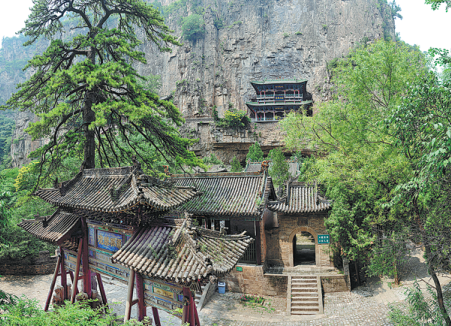Exploring Cangshan's historic hiding place
Updated: 2020-10-30

Temples were built in Cangshan to memorialize the story of Cheng Ying and the orphan of Zhao. [Photo by Liu Jinwei for China Daily]
During the 18th century, renowned French philosopher and author Francois-Marie Voltaire wrote a play called The Orphan of China and put it on stage.
The play was based on a real story that took place in Yuxian county in Shanxi province more than 2,600 years ago. Adapted from the popular Chinese opera The Orphan of Zhao, it caused great enthusiasm for Chinese culture among French intellectuals at that time.
And the mountain of Cangshan-which literally means the hiding mountain, some 18 kilometers north to the county seat, was the exact place where the orphan had been hidden for 15 years since he was an infant.
According to historical records, Zhao Dun, a high-ranking official in the Jin state during the Spring and Autumn Period (770-476 BC), was killed by his rival Tu'an Gu. Before his death, Zhao entrusted his only son, Zhao Wu, into the care of his close friend Cheng Ying.
Cheng honored his promise by living with the orphan in an secluded cave in Cangshan for 15 years. He successfully protected the child from being found and killed by his enemy until the monarch of Jin redressed the wrong doings against the Zhao family and gave the orphan noble status.
To memorialize Cheng's merit in honoring his promise to his friend, a temple was built near the cave in later years. A temple for Zhao Wu was also built, as he has been recognized as the ancestor of the Zhao families. The population of his descendants reached more than 26.7 million, according to a 2014 census tally.
The Cangshan area gradually developed into a tourist destination in later centuries, with more than 100 temples built in its vicinity in memory of Cheng and Zhao.
The local performance of The Orphan of Zhao, which is presented in storytelling, ballad singing and operas, has been included in the national-level intangible cultural heritage list.
The Cangshan scenic area, with more than 30 ancient buildings including temples, pavilions, towers and opera stages, as well as natural landscapes such as forest-covered mountains, deep valleys, waterfalls, ponds and caves, is a 4A tourist attraction-China's second highest level for tourist attractions.
Many tourists visit the site to connect with its history.
Zhao Ruili, a resident from Taiyuan, recently brought his 13-year-old son to the scenic area.
"Cangshan has played an important role in history as it offered a hiding place to one of the most influential figures," Zhao told his son.
"The descendants of Zhao Wu established the powerful Kingdom of Zhao, which marked the beginning of the Warring States Period (475-221 BC). And the number of his descendants increased steadily in the millenniums to come so that Zhao has become one of the top 10 family names in China," Zhao said.
Li Yali contributed to this story.



